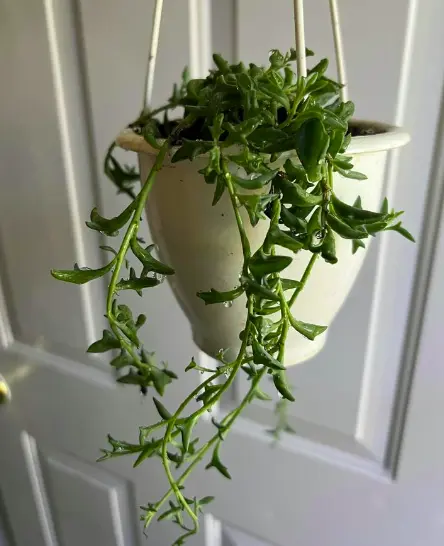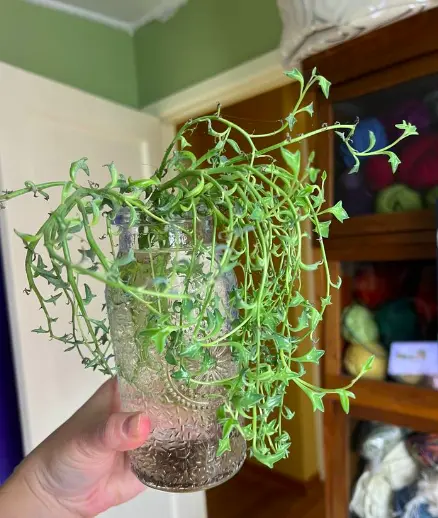A spectacle of beauty and wonder; that’s what their luscious leaves look like. String of Dolphins is so named because, if you’ve ever seen dolphins in their playtime, one look at these mesmerizing beauties in their fully grown stages would quickly give the impression of Dolphins diving out of water.
With a history of growing up to 3 feet long when properly maintained, String of Dolphins or Dendrophorbium peregrinum are grown as hanging ornamental indoor and outdoor garden plants whose strings cascade down higher positions in an attractive manner.
Let me walk you through the simple ways to propagate them in your home.
Propagating String of Dolphins

Your Dolphin String pots are overdue for propagation and reporting if they display these signs:
- When they look bushy and overgrown in their current pots
- When their attractive cascades become annoying because they now sprawl all over the available spaces, and it’s difficult to keep them in the hanging basket
- When they’ve been in a pot for up to 3 years, you need them young and fresh again.
- When they begin to get leggy, growing several long stems from the roots, that’s your cue their already looking for more sunshine and open spaces.
A string of Dolphins is mostly propagated from stem cuttings because of the process’s ease and simplicity. Stem Cuttings can further be rooted in water or potting soil.
Preparing the Dolphin Strings Stem Cuttings
Cuttings should be prepared during their active growing season, which falls between spring and summer annually. Ensure each stem cutting has a good number of healthy leaves (2-4 is great) and about 3-4 leaf nodes attached. The leaf nodes act as points for further root and shoot development in the future.
Cut off the stems from the plant using gardening scissors or a kitchen knife, with each cutting measuring at least 6 inches long. Now, remove any leaf at the lower end of the cuttings and place them on a dark, dry and warm surface for a few hours to heal, and the cuttings will be ready for rooting.
Rooting your Dolphin String Cuttings in Water

Get a transparent glass jar or potting vase and pour in distilled or natural untreated water. Ensure the water you’re using isn’t chlorinated, as that could hamper the growth of the cuttings. Rooting in water has several amazing benefits, but always remember to transplant your cuttings once their new roots grow up to 1-2 inches long.
Place your cuttings into the water jar, allowing them to lean from the sides; now, find a warm illuminated spot to position the water jar under the brilliance of indirect sunshine. Always change the water weekly or whenever it looks cloudy, and the roots will begin to grow after 2-3 weeks.
Watching the roots of the cuttings in water is always fun; sometimes, I even keep a video journal just for record purposes. It’s also a great learning opportunity for newbie propagators who want to observe what’s happening daily with the cuttings.
Rooting your Dolphin String Cuttings in a Potting Mix

A quicker and more straightforward approach to rooting your cuttings is directly in a Potting medium; you won’t have to worry about the newly grown roots rotting in the water due to prolonged stay when they should have been transplanted earlier.
First, get your rooting pots ready; several cuttings can be rooted in the same pot so you can determine the thickness and business of your Dolphin String pots.
Pour some potting soil mix into the pot and punch some holes on the surface at a depth of 1 inch using either your little finger or a chopstick.
Plant the callused cuttings in the holes and close the open spaces with more potting soil. If you prefer to use a rooting hormone, dip the cuttings’ ends first in the hormone compound before planting in the soil, but this is optional.
Next, water the pot thoroughly by misting or spraying until it looks drenched. You can place the pot on a flat open surface for the excess water to pour out through the draining holes at the sides and bottom.
Take the pot to a good spot where it will get good sunshine amounts daily, preferably beside a window frame and your cuttings will be rooted, growing new foliage after 2-4 weeks.
Growing your String of Dolphins in a Potting Medium
Whatever potting mix you choose, you should always remember to select a formula for a lightweight fast-draining, well-aerated potting mix. A soggy potting mix that holds water for too long would eventually cause the roots to rot and hamper their development.
I usually always remember to punch a few holes at the sides and bottom of my potting containers to ensure there’s no excess water hiding inside.
I’ll give a nod of approval for the Dolphin Strings concerning their ease of propagation and maintenance; caring for them is highly cost-effective and getting the right potting formula is easy.
A lightweight commercial cactus potting mix or succulent soil mix with enough sand and gravel for good percolation will do fine if the pH remains within the 6.6-7.5 range.
Here is a great mixing formula for making your homemade lightweight potting mix. Get 20% sharp sand, 20% perlite (horticultural pumice is also great), and 40% garden soil; mix these thoroughly, and you’re all good.
Watering Strings of Dolphins
Dolphin Strings are the perfect Succulent specimen in their water-holding capabilities. Their thick absorbent fleshy leaves can store water for extended periods, giving them a highly valuable endurance for drought conditions.
They don’t require many watering cycles, and frequent watering could easily result in root and leaf rots. Bottom watering is encouraged, whereby you lift their pots and dip them in a bowl of clean water, allowing them to sit for a few minutes to drain the excess water. Curly and wringly leaves are signs they’d prefer more watering sessions.
A great practice to keep them from losing too much water and cushioning against over-watering them is only to do so when the top 2 inches of the potting soil surface appears dry and crumbly. When the leaves turn pulpy, transparent, and soft, you can tell they’re overwatered. The roots also start looking darker with black or brownish colourations.
Giving your String of Dolphins the Required Sunshine Exposure
Dolphin Strings are the ideal image of an indoor garden plant requiring a brightly illuminated spot for them to grow and bloom lavishly. I don’t encourage sunbathing them directly when they’re still young, as that could lead to sunburns.
A perfect spot for them would be a west or south-facing window frame with more than 6 hours of daily indirect sunlight. Older pots, however, can be taken outside for an hour or two of direct sunshine exposure; doing this continually for a week or two would encourage them to bloom and display their colourful flowers.
Pruning your String of Dolphins
Pruning your Dolphin String pots has a lot of advantages: it removes dead or dying foliage, thereby encouraging the growth of new ones, regulates their adventurous wandering and crawling nature to remain within confined limits, and also gets them looking thicker and fuller for better aesthetic appeal.
Other fancy names for String of Dolphins include Flying Dolphins, Dolphin Necklace, Jumping Dolphin, and Dolphin Plant. Although they can be marked as slow bloomers, only reaching maturity after two years, these gorgeous creepers eventually catch up and make up for time lost, growing and blooming up to 100 cm tall at maturity.
Whatever you do with them, keep them away from pets: cats and dogs. Dolphin Strings are known to instigate mild toxicity in infants and animal pets; consumption or direct contact with its foliage or blooms might result in gastric disturbances such as diarrhoea, retching, nausea, and skin irritations.
